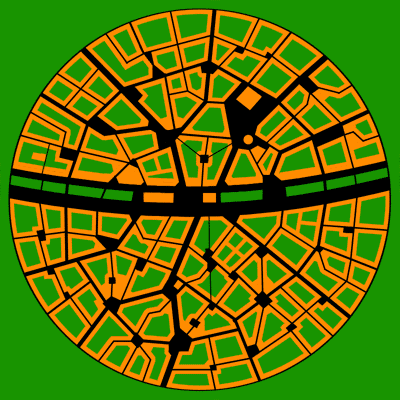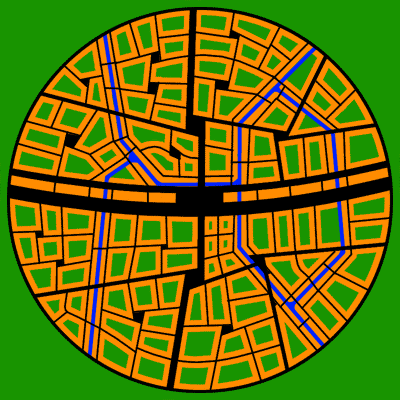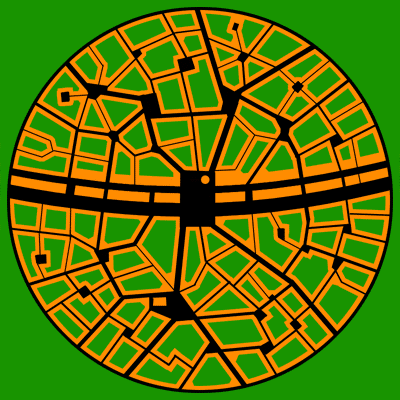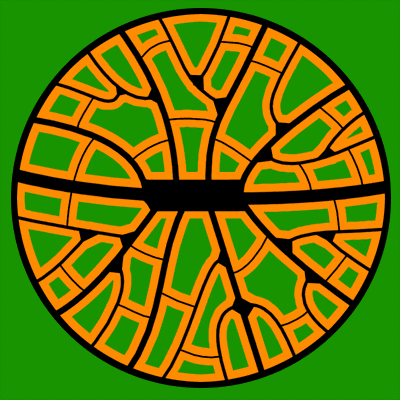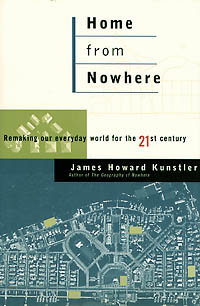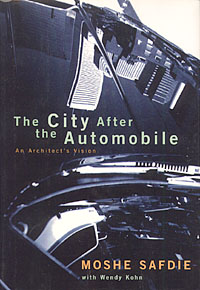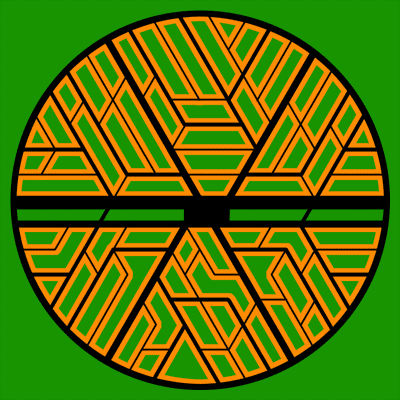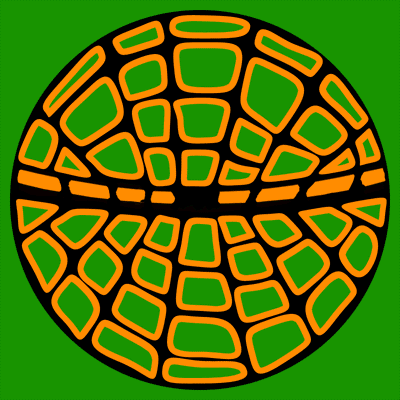|
|
|
Volume 1, Number 3 |
Published by Crawford Systems |
Summer 1997 |
|
New Neighborhood DesignsHere at Crawford Systems we have been hard at work developing new neighborhood designs. We have scattered them throughout this issue of Car-Free Times. The scale as reproduced on the Web is 1 pixel = 2 meters. The buildings shown vary from 10 to 15 meters thick depending on the size of the blocks in a particular design. The footprint of the buildings in all the designs approximates the 40% called for in the reference design. As you will see, an enormous variety of plans is possible within the broad constraints of the reference design for neighborhoods. We have only scratched the surface.We will soon be starting work on more highly developed lobe drawings, based on the new neighborhood designs. These will be followed by town plans and neighborhood details.
World News Notes & CommentEvery issue includes a section covering events related to the urban automobile in countries around the world. If you know of interesting developments, please pass them along for inclusion in the next issue.Car-Free LyonThe European Youth Forest Action (EYFA) will hold an international conference in Lyon, France. The conference is titled, "Towards Car-Free Cities." The is an activist group working to reduce urban automobile usage. The conference will include a public day to increase citizen awareness of the costs of automobile usage, its effects on cities, and some of the alternatives that are available now and in the future. I will present a plan for a car-free Lyon at the start of the conference. One work group track will address the issues in developing car-free cities. The conference will be held between 26 October and 1 November 1997. Look for details of the conference in the next Car-Free Times. For information on attending the conference, contact EYFA: |
|
EYFA, PO Box 94115, 1090 GC Amsterdam NL or lucia@eyfa.antenna.nl |
People Are Not MolesFor many years in auto-centric cities, pedestrians have been forced to use underpasses, just because it was not "practical" or safe to have them cross at street level. Cars were assumed to be more important than pedestrians. New thinking is that the city must again become pedestrian-friendly. In the case of a conflict of interests, then the cars must go into tunnels. In Strasbourg, France, when streets were redesigned for the new tram, cars were put underground and pedestrians use the surface, with easy access to the tram. Many pedestrians are also afraid to enter dark tunnels. |
| Sund Bytrafik |
Car Crashes Cost $150 BillionThe cost of US car crashes in 1994 was US$150.5 billion. This amounts to $580 per capita, or about 2.2% of GDP. The figures include an economic value on the lost productive years of those killed at $830,000 per life. The costs for critically-injured survivors is $706,000, nearly as much as for fatalities. About 24% of medical costs are paid directly by public agencies and are not reimbursed by either of the parties involved in the accident. 27 million vehicles were damaged in a crash in 1994. This is about 15% of the motor vehicle fleet. |
|
National Highway Traffic Safety Administration (US) Report Summary: The Economic Cost of Motor Vehicle Crashes - 1994, August 6, 1996 Contact: Barry McCahill as cited in Auto-Free Zone (December, 1996, Issue 17) |
|
Pedestrians' Progress in PortlandPortland, Oregon, has made major strides in furthering the interests of the pedestrian. Portland demolished a 4-lane freeway that once ran along the banks of the Willamette River. The freeway has been replaced by a two-mile park, and it is now quiet enough that the Portland Symphony gives concerts in the park. Free transit is provided in the 13 by 26 block downtown. |
|
"Pedestrian's Progress" John McKinney, LA Times (quoted in a news group). The issue date is probably mid-April 1997. |
If You Don't Like Modern Architecture, You're in Good CompanyArchitects complain that those who find their buildings ugly just don't have sufficient cultural sophistication to appreciate them, but this claim may be unfounded. Dutchman Harry Ganzeboom conducted a study in 1984 to demonstrate his hypothesis that the greater the cultural competence of an individual, the more highly that person will value semantically complex modern architecture. He showed his sample of 120 subjects 96 different photographs depicting old and new buildings, expecting that the more culturally sophisticated would like the modern buildings better. However, the results showed just the opposite: those with the highest cultural sophistication valued the old buildings even more than those judged to be less culturally sophisticated - excepting only the two architects in the sample. |
| NRC Handelsblad, 13 March 1997 |
Stockholm Creates Environment ZoneThe city of Stockholm has introduced environmental zones for heavy vehicles, those over 3.5 metric tons. Both atmospheric and noise pollution are considered in determining the rating for a particular vehicle. Vehicles which fail to meet the standards are not allowed inside the zones. There is talk of extending the measures to all motorized traffic. |
|
Report from the Car Free Cities' Conference 96 in Copenhagen, Car Free Cities Network |
Oil Production Might Peak as Early as 1999Dr. M. King Hubbert predicted in 1974 that global oil production would peak in about 1995. In 1956 he accurately predicted that US oil production would peak around 1970. The latest figures, using his very simple methodology, indicate that the global peak should come in 1999. Other experts give dates as late as 2010. |
| The Global Hubbert Peak |
Car Pollution in BeijingThe Chinese press has warned that automobile pollution is threatening public health. The authorities are becoming increasingly aware of the need to introduce measures to restrict the number of cars and the resulting emissions. The number of cars in Beijing has increased more than four-fold in just ten years. |
| Car Free Cities Newsletter, July 1997, Issue 13 |
Free Buses in HasseltThe city of Hasselt in Belgium will provide free bus service between 1 July and 31 December, 1998. At the same time, measures will be adopted to discourage cars from entering the center city. The mayor hopes to encourage permanent changes in driving behavior. The public transport company expects a five-fold ridership increase. |
| Car Free Cities Newsletter, July 1997, Issue 13 |
Roads and Politics Collide"The anti-roads campaign has turned into a populist protest movement drawing support across age, social and political barriers... The breadth of the anti-roads coalition has begun to rattle the ruling Conservatives, who already rank abysmally low in the polls." |
|
Time Magazine, 5 September 1994 as quoted in Alarm Bells, Issue 20, published by Alarm UK, 9/10 College Terrace, London E3 5AN, GB |
Warning: Congestion AheadThe US General Accounting Office predicts that US road congestion will triple in 15 years even if road capacity is increased by 20%, a figure regarded as unlikely to be reached. |
|
"The Problem with Paving," Alliance for a Paving Moratorium PO Box 4347, Arcata, CA 95518, USA |
EuroTop on BikesDuring the EuroTop in June, The Netherlands gave all 15 heads of state a bicycle with which to ride to their lunch gathering one afternoon. Germany's Helmut Kohl, rather on the plump side, declined to pedal but the others gamely jumped aboard their new bikes, even the Finnish leader, who needed a little steadying. Amsterdam Mayor Patijn gave the Dutch commissioner to the EU, Hans van den Broek, a lift on the back of his bike, in good Dutch fashion. |
| Dutch TV |
Rail-Volution ConferenceBetween 26 and 29 October 1997 the Rail-Volution conference will be held in St. Louis, Missouri. It's about rail transit and land use planning. They claim "No need to rent a car!" to attend the event, being held at Union Station. More information from: |
| Rail-Volution '97, Hudson Cross Roads, Selbyville, DE, USA 19975. |
|
Stronger Measures Against CO2 NeededIn 1992, the EU set modest targets for CO2 reduction. The goal was to reduce CO2 emissions in the EU to 1990 levels by the year 2000. The richer countries in the EU were to achieve a 3-5% reduction so that the poorer nations could enjoy some economic growth. In reality, The Netherlands is probably going to see a 10% increase between 1990 and 2000, and many other countries are also failing to meet their targets. |
| NRC Handelsblad March or Feb 1997 |
Miscellaneous Facts about Cars and Trucks
|
|
Trans-mission, Transportation Options (427 Bloor Street West Toronto, Ont. M5S 1X7, Canada) Summer 1992 |
|
|
"The Problem with Paving," Alliance for a Paving Moratorium PO Box 4347, Arcata, CA 95518, USA |
|
| "A Positive Alternative," Alliance for a Paving Moratorium |
|
|
The World Bank, "The Urban Age," Fall 1993 as quoted in: "Why Transportation Shouldn't be Cars," Alliance for a Paving Moratorium |
|
Review: Home from NowhereJames Howard Kunstler has attacked North American sprawl development with a chain saw. When the dust clears, only splinters remain. The author visited many American cities and paints horrifying pictures of most of them. Scattered in between are a few refreshing visits to New Urbanism developments and some sad stories of what-might-have-been. Kunstler's observations are the narrative glue that hold the book together. Kunstler's writing speaks for itself, so I include these fragments:
I believe that certain physical relationships work well because they are consistent with human psychological needs that are probably universal and haven't changed over time. A consideration of these issues leads ineluctably to the condition we call beauty, which for too long has been dismissed as an insoluble mystery of "taste," or worse, relegated by the academic avant-garde to the dumpster of irrelevance. When intellectuals take the position that beauty is a subject beneath discussion, it seems to me that a culture is in real trouble. The old towns and old buildings we cherish are great not necessarily because architects were so much better trained in 1848 or 1908 - though it may be so - but because a consensus demanded better work, and especially work more respectful of the public realm. This book seeks to restore those standards at the popular level. We arrive at the recognition that civilization needs an honorable dwelling place, and that the conditions of making that place ought to depend on what is most honorable in our nature: on love, hope, generosity, and aspiration. The public realm in America became so atrocious in the postwar decades that the Disney Corporation was able to create an artificial substitute for it and successfully sell it as a commodity. That's what Disney World is really about.
The book is written from an American perspective. (For those who have never visited America, the devastation of most US inner cities can only be likened to the aftermath of war.) Kunstler devotes considerable attention to America's traditional hatred of cities and the damage this attitude has done to the American psyche. Europeans have always rightly regarded cities as the badge of civilization. The current American anomie will endure until the country decides to respect its cities and treat them better. Kunstler devotes considerable attention to the history of the city in America because he correctly perceives that an understanding of how America got into its current mess is central to finding a way out. Kunstler tells us that America needs to respect the public realm and the common good once again. That these notions are now held in disrepute is a good barometer for just how far America has sunk. Such notions were held as a central civic good as recently as 1945. People no longer care enough about the public realm to spend money on decorating buildings in order to enhance public spaces. This lack of concern has resulted in an environment in which most people feel deeply uneasy. As well they should. Kunstler devotes a whole chapter to the American obsession with the automobile and the enormous costs it exacts. "We have all the information we need to persuade us by means of rational argument that using cars the way we do is catastrophic. The trouble is we don't care." Charm is a central theme in the book, and much attention is given to how to create it. He looks deeply into the root cause of American placelessness and concludes, "All you can build where I live, in upstate New York, is another version of Los Angeles. The zoning laws say so. This is not a gag." American zoning laws expressly forbid the kind of development that leads to places people care about. Development in the traditional model that most Americans value will not be possible until the zoning laws have been changed. Kunstler goes into considerable detail about how this can be achieved, principally by applying the principles of the New Urbanism. New York City rates its own chapter. Kunstler and I are the same age, and while he was growing up on the Upper East Side, I was growing up in the country only 35 miles away. For me, New York was a rare treat, and I vividly remember my visits. Kunstler had free rein of Manhattan from age 9. It was then probably the greatest cultural resource in all history, and Kunstler took full advantage of it. New York has now largely succumbed to the usual collection of US urban woes. Kunstler has told me in private correspondence that friends living in his former New York neighborhood find it necessary to escort their children everywhere, even when they are as old as 13. This is a terribly sad change and deprives today's kids of the vast and wonderful experience that was Kunstler's. Kunstler does not go so far as to suggest that automobiles should be eliminated from cities, although he makes it crystal clear that their dominance must be tempered. The one place where I depart from Kunstler is in this belief, also generally held by the New Urbanists, that it is possible to get the automobile back into the cage and build cities that are for pedestrians and not for cars. To a considerable extent, I think they may be right. I believe, however, that the costs of the remaining low level of automobile usage are high enough that the car-free alternative makes the most sense. Kunstler's writing is nothing if not vivid, and his sharp sense of humor had me laughing out loud. This is a book for everyone who loves cities, despises what has happened to them, and can't stand to see one more suburban subdivision. |
|
James Howard Kunstler, Home from Nowhere: Remaking our everyday world for the 21st century (New York: Simon & Schuster, 1996) |
|
Review: The City After the AutomobileThis short book by noted Canadian architect Moshe Safdie is an interesting disappointment. Safdie is known for many imaginative works, foremost among them Habitat '67, a unique residential structure built as part of the 1967 Montreal world's fair. In his latest book, Safdie looks at the current condition of cities and concludes that they come up short.Safdie is well aware of the ravages of the automobile. He despises the loss of place which contemporary patterns of auto-centric development have imposed on vast areas of North America. He clearly understands the tremendous importance of public spaces which bring people together and where casual encounters are possible. He knows that modern skyscrapers brutalize their occupants. He understands that modern architecture glorifies the architect and his client but that most modern buildings turn their backs on the cities that gave them birth. These understandings alone put him far ahead of most of his colleagues. Safdie makes much of the tremendous changes in scale that have characterized the 20th century. In a century, the tallest building has increased from 26 stories to 110 stories. "New towns" a century ago were for 30,000 people; today Singapore knocks off a town for 200,000 with regularity. Tokyo has grown from 1.8 million to 27 million in a century. The Burlington Arcade in London, once the world's foremost shopping center, had 54 shops and 22 stands. The West Edmonton Mall has more than 800 hundred stores. And so it goes. Things certainly are bigger than they used to be. But what of it? Should we abandon traditional forms which have worked for centuries for mega-scale? Before we do so, it would be well to have a good look at just what is involved. Safdie dismisses the New Urbanism, with its low-rise buildings, small lots, and narrow streets, without giving it serious consideration. This pattern is in fact capable of hosting large cities. The gigantic buildings which characterize modern city centers are unnecessary even in very large cities. Because of the volume lost to elevators and the need for large setbacks (to keep them from totally dominating the cityscape), the skyscraper is less efficient in its use of land than one might assume. Couple this with the need for a substantial infrastructure to handle car parking and streets and the actual F.A.R. (Floor Area Ratio) of downtown skyscraper cores is not all that high. The density of the Car-Free City, with its narrow streets and absence of internal parking, is somewhat higher than that of the New Urbanism and is sufficient to host even a mega-city. Safdie's summary dismissal of the New Urbanism is all the more peculiar given his belief that suburbs in their current form can continue to exist. Given that the New Urbanism yields towns that are much less dependent on the automobile and much denser than the sprawling suburbs we have built since WW II, it is hard to see why he finds no useful application for this form. He appears to believe that we should build on two scales: very low density suburbs in much their current form and very high density city cores with numerous skyscrapers ranged along a pedestrian precinct served by a people-mover system. These cores and the suburbs are tied together by a variety of public transportation systems and the "U-car," the utility car. The U-car is rented on an as-needed basis (for single journeys or for days at a time) and discarded at a U-car facility when entering the city. When it's time to go, you just pick up another U-car. The design admits of a large reduction in the amount of space required for parking, and probably a significant reduction in the number of cars and the distance they are driven. It does not, however, answer the problem of the vast highway networks required to tie the suburbs to the city nor the issue of the environmental impacts of cars, even the advanced battery-powered, electronically guided vehicles he proposes. It certainly does nothing to bring the suburbs out of the ozone and back into the real world. I fear that Safdie's U-car, while it might solve some problems and mitigate others, is not a long-term solution to our problems. The logistics of bringing superhighways, automated U-car parking facilities, train stations, people mover terminals, and pedestrian precincts in close proximity to each other are going to require multi-layer concrete megaliths which will be hugely expensive. Safdie correctly understands that the conjunction of all these transport modes is essential to achieve his vision. And how does the freight get delivered in the midst of all this? The book is short and readable but rather sparsely illustrated for a work of its kind. While Safdie's vision is an interesting one, and certainly an improvement on what we have now, I do not believe that it is a realistic model for improving our cities at a cost we can afford. |
|
Moshe Safdie with Wendy Kohn, The City After the Automobile: An Architect's Vision (New York: HarperCollins, 1997) |
The City of TomorrowExcerpts from an interview with Peter Calthorpe by Scott London.
...We've been doing several large projects in Southeast Asia. Most of what I have to report is rather depressing. China, for instance, is going in totally the wrong direction. They just put across a policy that said that the automobile is going to be their chosen transportation system. That is a very frightening decision. Very frightening. But that is how they are going to steer their infrastructure dollars and their industrial investments. That one decision is monumental. |
| From the radio series Insight & Outlook |
|
Car Free Cities NetworkDG XI (Environment) of the European Union has sponsored the Car Free Cities network. This is an association of more than 60 European cities working together to reduce the burden of the automobile on the city. There are several working groups:
The Copenhagen DeclarationThe 1996 Annual General Meeting of the Car Free Cities Network adopted a declaration on "Mobility Culture." The following are excerpts from the declaration:
.... At present the car is almost always given priority over pedestrians and cyclists, whose routes and paths are determined by the desire to minimise motorised vehicle travel time. The car is treated as more than a form of transport, with a status additional to the travel opportunities it provides. We need to encourage lifestyles which are less dependent upon cars. 4. The undersigning cities have agreed that the following strategies need to be implemented through the co-operative efforts of all relevant actors and levels of government. |
| Car Free Cities Magazine, January 97, number 1 |
Subscribe to Car-Free TimesCar-Free Times is published four times a year on the Crawford Systems World Wide Web site, carfree.com. We can send you e-mail notification of each new issue. Please send e-mail with the word Subscribe in the subject line. You will receive automatic e-mail notification of each new issue, with the URL for the new issue. We also use the notification list to announce major revisions to the Cities for People site.Contact Information |
| J.H. Crawford, President | |
| Crawford Systems | |
| Tel. | +31 20 638 5115 |
| Send e-mail | |
| URL | http://www.carfree.com/ |
